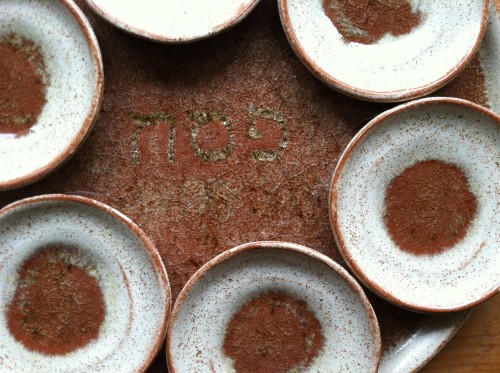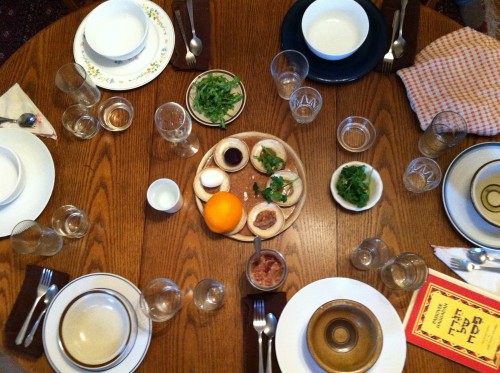I don’t have any photos to show you about making matzo, but I have a good reason: from the moment the water touches the flour, you have 18 minutes to knead and roll all of your matzot, and get them all in the oven. 18 minutes. It’s like an event at a kitchen decathlon. And my matzo’s not even, strictly, kosher for Passover.
Okay, I’ll back up a little here. Happy Passover! Last night was the first evening of this holiday that commemorates the Hebrews’ escape from Egypt, and my friends and I gathered to celebrate the Seder, the ceremonial meal during which you recite the story of the Exodus through symbols, songs, and prayer. It’s a bit of a bittersweet holiday, what with the ten plagues and forty years wandering the desert and all, but I enjoy it every year. Part of me thrills to the challenge of not eating anything leavened for a whole eight days (no grains or legumes when you eat mostly vegetarian leads to a lot of creativity). Partly I carry on this tradition because it’s how I was raised, and because it connects me to family, those gone and those far away. But this year I realized what is probably the most fundamental reason why Passover has survived in my pared-down religious practice: everything you do during Passover has to do with food.
We spend eight days eating with more intention and consciousness than in all the rest of the year. We literally eat the Passover story, from the mortar the slaves used to build the pyramids (charoset) to the tears they shed (salt water) to the unleavened bread they carried on their backs (matzo). All of the foods in the world are separated into three categories: chametz, leavened foods that are strictly forbidden; kitniyot, legumes, grains, and seeds that must be avoided because they could be confused with chametz; and everything else. For eight days, we name each bit of food that passes before us: chametz, kitniyot, parve (kosher). And in naming them we give them power.
But I am beginning to think this year that it is not just the naming, the ritual categorization and symbolism, that gives power to food during Passover. It is also that the rules of Passover, these seemingly arbitrary lists of what is okay and what is not okay, and when, and why you need to make 18-minute matzo, speak very fundamentally to the way we make food. Historically Jews avoided legumes during Passover because they would have been threshed, dried, and milled in the same places as the forbidden wheat, so in order to be absolutely sure that your food was pure, you had to avoid these as well.
The wheat for matzo, on the other hand, would have been carefully monitored and segregated from the field to the oven, so here the challenge is to maintain its purity and keep it from rising. Matzo has to be made with mayim shelanu, ‘water which has slept’–that is, water that has been left out overnight to cool. I suspect this is to ensure that the water is no warmer than room temperature and thus delays the wild yeast activity that occurs at warmer temperatures. Likewise, 18 minutes is set as the deadline after which fermentation begins to occur at an unacceptable rate.
Scientific? No. But all of these strange rules and poetic symbols come together to talk about something very basic: know where your food comes from. Understand how it is made. Use it consciously. And give thanks.
So here is my commitment to myself and to you: I am going to eat intentionally and deeply this week. I am going to give power to my food and the system from which it came. I may not have any revelations or change in values at the end of it, but at least I will be closer to understanding how something as poetic as letting water sleep is really just a way of regulating temperature; and something as simple as a piece of unsalted, unleavened bread is really a story about people coming together to feast.
Please be aware that regular store-bought flour is not kosher for Passover; however you can, like I did, follow the spirit of the law rather than the letter.
I was unable to get my matzot to bake to a cracker consistency in the allotted time, but I decided that if I couldn’t manage it in a 425° oven, it was unlikely the ancient Hebrews actually ended up with crackers on their backs in the desert sun. These little flatbreads are probably more like what they ate than commercial matzot.
Homemade Matzot
2 C whole wheat flour
1/2-1 C water
If you’re making these for Passover, each piece of matzo needs to start baking no more than 18 minutes from when you began mixing the dough, so make sure your oven is preheated well. You may even want to preheat a couple griddles on the stovetop to be safe.
Set the oven rack at the bottom of the oven, place one large baking sheet or two small ones on the rack, and preheat the oven to 425°. Make sure all of your equipment is laid out: you will need a sheet of plastic wrap, a floured surface, a rolling pin, extra flour for rolling, and a fork to prick holes in the matzo.
When your oven is preheated, mix just enough water into your flour to make a workable dough (start with 1/2 C and add a little at a time as needed). Turn out onto a floured surface and knead for 3-4 minutes. Divide the dough into 12 equal pieces and flatten each piece slightly between your palms. Keep the extra pieces of dough under plastic wrap.
Working quickly, roll out each piece of dough as thinly as you can, keeping your rolling pin well-floured. Prick holes all over the dough with your fork, stretch the dough a little between your hands, and place in the oven or on the griddle. Each piece will take a few minutes to bake and should brown slightly at the edges. Cool on a wire rack.




Thank you for this! learnt a little more about Jewish customs today 🙂 A lot of our Indian cooking for fasts & festivals is like this too, as is i seems arbitrary & random, but if you get down to it there are always some logic to it.
Happy to share! I would love to learn more about other cultures’ feasting and fasting customs as well.
Thought you might want to read this 🙂 We just had our Spring festival, & I wrote a bit about it.
Now I have the bread recipe for my house’s Maundy Thursday supper!
But please, I thought aliens built the pyramids. Have I been misinformed?
Great post and really nice pictures!